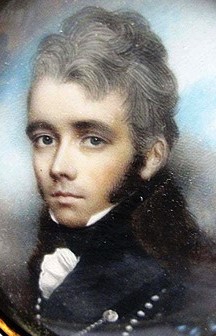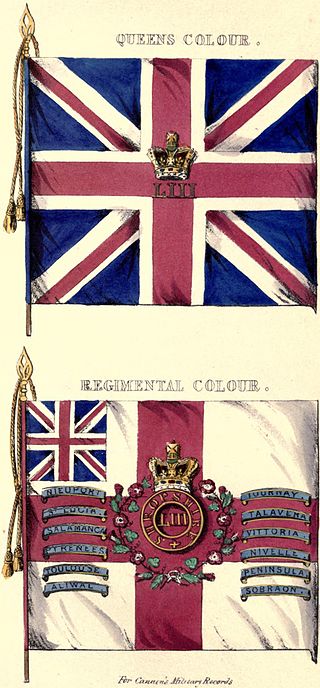Related Research Articles
The New South Wales Corps, later known as the 102d Regiment of Foot, and lastly as the 100th Regiment of Foot, was a formation of the British Army organised in 1789 in England to relieve the New South Wales Marine Corps, which had accompanied the First Fleet to New South Wales. In Australia, the New South Wales Corps gained notoriety for its trade in rum and mutinous behaviour.

Lieutenant-General Sir William Stewart, GCB was a British military officer who was the first Commanding Officer of the Rifle Corps, a Division Commander in the Peninsular War and a Scottish Member of Parliament (MP) in the British Parliament.

The 53rd (Shropshire) Regiment of Foot was a British Army regiment, raised in 1755. Under the Childers Reforms it amalgamated with the 85th Regiment of Foot to form the King's Shropshire Light Infantry in 1881.

The 31st (Huntingdonshire) Regiment of Foot was an infantry regiment of the British Army, raised in 1702. Under the Childers Reforms it amalgamated with the 70th (Surrey) Regiment of Foot to form the East Surrey Regiment in 1881.
The 69th Regiment of Foot was an infantry regiment of the British Army, raised in 1756. Under the Childers Reforms it amalgamated with the 41st (Welch) Regiment of Foot to form the Welch Regiment in 1881.
The 130th Regiment of Foot was an infantry regiment of the British Army, created in 1794. After being raised it was sent to the West Indies, where it suffered heavy losses from tropical disease. The unit was disbanded at Santo Domingo in 1796, with the survivors drafted into other regiments.

The 81st Regiment of Foot (Loyal Lincoln Volunteers) was an infantry regiment of the British Army, raised in 1793. Under the Childers Reforms it amalgamated with the 47th (Lancashire) Regiment of Foot to form the Loyal North Lancashire Regiment in 1881.

The 86th Regiment of Foot was an infantry regiment of the British Army, raised in 1793. Under the Childers Reforms it amalgamated with the 83rd Regiment of Foot to form the Royal Irish Rifles in 1881.
The 111th Regiment of Foot (Loyal Birmingham Volunteers) was an infantry regiment of the British Army from 1794 to 1796. It was formed on 30 May 1794 and disbanded in February 1796.
The 109th (Aberdeenshire) Regiment of Foot was an infantry regiment of the British Army from 1794 to 1795. Raised by Alexander Leith Hay for service in the French Revolutionary Wars the regiment was briefly deployed in Jersey before it was disbanded in England and its men sent to reinforce the 53rd (Shropshire) Regiment of Foot. The disbandment was controversial as Leith-Hay believed it contravened an assurance given to him in his original letter of service to raise the regiment.
The 99th Regiment of Foot (Jamaica Regiment) was an infantry regiment of the British Army, raised in 1780 by Charles Rainsforth and disbanded in 1783.

Field Marshal Sir Edward Blakeney was a British Army officer. After serving as a junior officer with the expedition to Dutch Guiana and being taken prisoner by privateers three times suffering great hardship, he took part in the Anglo-Russian invasion of Holland in 1799. He also joined the expedition to Denmark led by Lord Cathcart in 1807. He went on to command the 2nd Battalion of the 7th Regiment of Foot and then both battalions of that regiment at many of the battles of the Peninsular War. After joining the Duke of Wellington as he marched into Paris in 1815, Blakeney fought in the War of 1812. He then commanded a brigade in the army sent on a mission to Portugal to support the constitutional government against the absolutist forces of Dom Miguel in 1826. His last major appointment was as Commander-in-Chief, Ireland, a post he held for nearly twenty years.
The 102nd Regiment of Foot was a short-lived regiment of the British Army raised in 1793 and disbanded in 1795.
The plan of raising a fencible corps in the Highlands was first proposed and carried into effect by William Pitt the Elder, in the year 1759. During the three preceding years, both the fleets and armies of Great Britain had suffered reverses, and it was thought that a "home guard" was necessary as a bulwark against invasion.

Gen. Sir Josiah Champagné was a British military commander who was the fifth General Officer Commanding, Ceylon. He was appointed in February 1799 until 1799. He was succeeded by Hay MacDowall.
Charles Best was a British army officer of Hanoverian descent who served in the armies of the East India Company, Britain and Hanover from 1781 until the end of the Napoleonic Wars.

The 99th Infantry Regiment was an infantry regiment of the French Army. It was formed in 1791 by renaming the Royal Deux-Ponts Regiment and fought in the French Revolutionary Wars before being merged into another unit in 1803.
General Christopher Chowne, born Christopher Tilson and also known as Christopher Tilson-Chowne, was a British Army officer most notable for his service in the Peninsular War. He joined the army in 1788 and after periods of service in the 23rd Regiment of Foot and an Independent Company, he became lieutenant-colonel of the 99th Regiment of Foot in 1794. The 99th were disbanded in 1797, and Chowne joined instead the 44th Regiment of Foot in 1799. He commanded the regiment at the battles of Abukir and Mandora in the British campaign in Egypt in 1801. In 1805 he was appointed a brigadier-general, as which he served in the Anglo-Russian occupation of Naples later in the year and subsequently in the West Indies.
The York Light Infantry Volunteers, also known as the Barbados Volunteer Emigrants, was a foreign light infantry regiment of the British Army during the Napoleonic Wars. It was formed in September 1803 from the Dutch garrisons of the captured Batavian colonies of Demerara, Essequibo, and Berbice. Additions to the regiment were recruited from the ranks of prisoners of war, and the regiment was also the recipient of the majority of deserters taken in the Peninsular Wars. The regiment served its whole existence in the West Indies, fighting in the British West Indies campaign. It was present at the Battle of Suriname in 1804 and at the invasions of Martinique and Guadeloupe in 1809 and 1810 respectively. It finished the Napoleonic Wars as garrison at Jamaica, before in early 1817 being sent to England, where it was disbanded on 19 March.
References
- ↑ Chichester, Henry Manners. . Dictionary of National Biography . Vol. 20. pp. 426–427.
- 1 2 Brown, Steve. "British Regiments and the Men Who Led Them 1793-1815: the "Ephemeral Corps" 1793-1796". The Napoleon Series. Retrieved 19 January 2014.
- ↑ "Regiments stationed on Isle of Man, 1765-1896". www.isle-of-man.com. Retrieved 13 June 2016.
- ↑ Coulburn's United Service Magazine and Naval and Military Journal, Part 1. London: H Hurst. 1851. p. 558.
- ↑ Frederick, J.B.M. (1969). Lineage book of the British Army: mounted corps and infantry, 1660-1968. Cornwallville, NY: Hope Farm Press. p. 312.